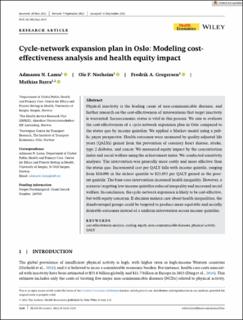| dc.contributor.author | Lamu, Admassu Nadew | |
| dc.contributor.author | Norheim, Ole Frithjof | |
| dc.contributor.author | Gregersen, Fredrik A. | |
| dc.contributor.author | Barra, Mathias | |
| dc.date.accessioned | 2022-02-03T14:22:58Z | |
| dc.date.available | 2022-02-03T14:22:58Z | |
| dc.date.created | 2021-10-09T17:30:33Z | |
| dc.date.issued | 2021 | |
| dc.identifier.issn | 1057-9230 | |
| dc.identifier.uri | https://hdl.handle.net/11250/2976964 | |
| dc.description.abstract | Physical inactivity is the leading cause of non-communicable diseases, and further research on the cost-effectiveness of interventions that target inactivity is warranted. Socioeconomic status is vital in this process. We aim to evaluate the cost-effectiveness of a cycle-network expansion plan in Oslo compared to the status quo by income quintiles. We applied a Markov model using a public payer perspective. Health outcomes were measured by quality-adjusted life years (QALYs) gained from the prevention of coronary heart disease, stroke, type 2 diabetes, and cancer. We measured equity impact by the concentration index and social welfare using the achievement index. We conducted sensitivity analyses. The intervention was generally more costly and more effective than the status quo. Incremental cost per QALY falls with income quintile, ranging from $10,098 in the richest quintile to $23,053 per QALY gained in the poorest quintile. The base-case intervention increased health inequality. However, a scenario targeting low-income quintiles reduced inequality and increased social welfare. In conclusion, the cycle-network expansion is likely to be cost-effective, but with equity concerns. If decision makers care about health inequalities, the disadvantaged groups could be targeted to produce more equitable and socially desirable outcomes instead of a uniform intervention across income quintiles. | en_US |
| dc.language.iso | eng | en_US |
| dc.publisher | Wiley | en_US |
| dc.rights | Navngivelse 4.0 Internasjonal | * |
| dc.rights.uri | http://creativecommons.org/licenses/by/4.0/deed.no | * |
| dc.title | Cycle-network expansion plan in Oslo: Modeling costeffectiveness analysis and health equity impact | en_US |
| dc.type | Journal article | en_US |
| dc.type | Peer reviewed | en_US |
| dc.description.version | publishedVersion | en_US |
| dc.rights.holder | Copyright 2021 The Authors | en_US |
| cristin.ispublished | true | |
| cristin.fulltext | original | |
| cristin.qualitycode | 2 | |
| dc.identifier.doi | 10.1002/hec.4435 | |
| dc.identifier.cristin | 1944617 | |
| dc.source.journal | Health Economics | en_US |
| dc.source.pagenumber | 3220-3235 | en_US |
| dc.relation.project | Norges forskningsråd: 260588 | en_US |
| dc.identifier.citation | Health Economics. 2021, 30 (12), 3220-3235. | en_US |
| dc.source.volume | 30 | en_US |
| dc.source.issue | 12 | en_US |

